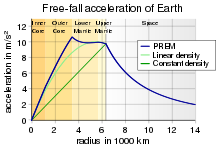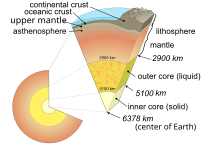User:Scienceisfun69/sandbox

Structures of the Earth
The Earth has a layered structure made up of the core[1], mantle[2] and crust[3]. Most of what we know about the interior of the Earth comes from the study of seismic waves from earthquakes. Seismic waves from large earthquakes pass throughout the Earth.
These waves contain vital information about the internal structure of the Earth. As seismic waves pass through the Earth, they are refracted, or bent, like rays of light bend when they pass though a glass prism.
Because the speed of the seismic waves depends on density, we can use the travel-time of seismic waves to map change in density with depth, and show that the Earth is composed of several layers.
Inner Core
[edit]______________________________________________________________________________________________________________________________________________________
Temperature: 5,000°C - 6,000°C State: Solid Composition: iron and nickel

The Earth’s inner core is a huge metal ball, 2,500km wide. Made mainly of iron, the temperature of the ball is 5,000°C to 6,000°C – that’s up to 6,000 times hotter than our atmosphere and scorching enough to make metal melt! The metal at the inner core stays solid because of the incredible pressure surrounding it.
Outer Core
[edit]______________________________________________________________________________________________________________________________________________________

Temperature: 4,000°C – 6,000°C State: Liquid Composition: iron, nickel, sulphur and oxygen
This liquid layer of iron and nickel is 5,150km deep. The outer core flows around the centre of the Earth, and the movement of the metals creates our planet’s magnetic field.
Lower Mantle
[edit]______________________________________________________________________________________________________________________________________________________

Temperature: 3,000°C State: solid Composition: iron, oxygen, silicon, magnesium and aluminium
The lower mantle is found between 670km and 2,890km below the surface, and is made from solid rock. The rock is hot enough to melt, but is solid because of the pressure pushing down on it.
Upper Mantle
[edit]______________________________________________________________________________________________________________________________________________________

Temperature: 1,400°C – 3,000°C State: liquid / solid Composition: iron, oxygen, silicon, magnesium and aluminium
This layer is up to 670km below the Earth’s surface. The lower part of the upper mantle is made from both solid and melted rock (liquid), while the rock in the upper region is stiffer, because it’s cooler.
Crust
[edit]________________________________________________________________________________________________________________________________________________________ Temperature: Around 22°C State: Solid Composition: Oceanic crust made up of iron, oxygen, silicon, magnesium and aluminium.
Continental crust made up of granite, sedimentary rocks and metamorphic rocks.
The crust ranges from 5–70 km (~3–44 miles) in depth and is the outermost layer. The thin parts are the oceanic crust, which underlie the ocean basins (5–10 km) and are composed of dense (mafic) iron magnesium silicate igneous rocks, like basalt. The thicker crust is continental crust, which is less dense and composed of (felsic) sodium potassium aluminium silicate rocks, like granite. The rocks of the crust fall into two major categories – sial and sima (Suess,1831–1914). It is estimated that sima starts about 11 km below the Conrad discontinuity (a second order discontinuity). The uppermost mantle together with the crust constitutes the lithosphere. The crust-mantle boundary occurs as two physically different events. First, there is a discontinuity in the seismic velocity, which is most commonly known as the Mohorovičić discontinuity or Moho. The cause of the Moho is thought to be a change in rock composition from rocks containing plagioclase feldspar (above) to rocks that contain no feldspars (below). Second, in oceanic crust, there is a chemical discontinuity between ultramafic cumulates and tectonized harzburgites, which has been observed from deep parts of the oceanic crust that have been obducted onto the continental crust and preserved as ophiolite sequences.
Many rocks now making up Earth's crust formed less than 100 million (1×108) years ago; however, the oldest known mineral grains are 4.4 billion (4.4×109) years old, indicating that Earth has had a solid crust for at least that long.[4]
Mantle
[edit]————————————————————————————————————————————————————————————————————————————————————————————————————————————————————————————————————————————————————————— temperatures range between 500 to 900 °C (932 to 1,652 °F) State: Solid

Earth's mantle extends to a depth of 2,890 km, making it the thickest layer of Earth. The mantle is divided into upper and lower mantle. The upper and lower mantle are separated by the transition zone. The lowest part of the mantle next to the core-mantle boundary is known as the D″ (D prime prime) layer. The pressure at the bottom of the mantle is ~140 GPa (1.4 Matm). The mantle is composed of silicate rocks that are rich in iron and magnesium relative to the overlying crust. Although solid, the high temperatures within the mantle cause the silicate material to be sufficiently ductile that it can flow on very long timescales. Although solid, the high temperatures within the mantle cause the silicate material to be sufficiently ductile that it can flow on very long timescales. Convection of the mantle is expressed at the surface through the motions of tectonic plates. As there is intense and increasing pressure as one travels deeper into the mantle, the lower part of the mantle flows less easily than does the upper mantle (chemical changes within the mantle may also be important). The viscosity of the mantle ranges between 1021 and 1024 Pa·s, depending on depth.[5] In comparison, the viscosity of water is approximately 10−3 Pa·s and that of pitch is 107 Pa·s. The source of heat that drives plate tectonics is the primordial heat left over from the planet’s formation as well as the radioactive decay of uranium, thorium, and potassium in Earth’s crust and mantle. [6]
Core
[edit]_______________________________________________________________________________________________________________________________________________________ Temperature:

The average density of Earth is 5,515 kg/m3. Because the average density of surface material is only around 3,000 kg/m3, we must conclude that denser materials exist within Earth's core. Seismic measurements show that the core is divided into two parts, a "solid" inner core with a radius of ~1,220 km[7] and a liquid outer core extending beyond it to a radius of ~3,400 km. The densities are between 9,900 and 12,200 kg/m3 in the outer core and 12,600–13,000 kg/m3 in the inner core.[8]
The inner core was discovered in 1936 by Inge Lehmann and is generally believed to be composed primarily of iron and some nickel. It is not necessarily a solid, but, because it is able to deflect seismic waves, it must behave as a solid in some fashion. Experimental evidence has at times been critical of crystal models of the core.[9] Other experimental studies show a discrepancy under high pressure: diamond anvil (static) studies at core pressures yield melting temperatures that are approximately 2000 K below those from shock laser (dynamic) studies.[10][11] The laser studies create plasma,[12] and the results are suggestive that constraining inner core conditions will depend on whether the inner core is a solid or is a plasma with the density of a solid. This is an area of active research.
In early stages of Earth's formation about four and a half billion (4.5×109) years ago, melting would have caused denser substances to sink toward the center in a process called planetary differentiation (see also the iron catastrophe), while less-dense materials would have migrated to the crust. The core is thus believed to largely be composed of iron (80%), along with nickel and one or more light elements, whereas other dense elements, such as lead and uranium, either are too rare to be significant or tend to bind to lighter elements and thus remain in the crust (see felsic materials). Some have argued that the inner core may be in the form of a single iron crystal.[13][14]
Under laboratory conditions a sample of iron–nickel alloy was subjected to the corelike pressures by gripping it in a vise between 2 diamond tips (diamond anvil cell), and then heating to approximately 4000 K. The sample was observed with x-rays, and strongly supported the theory that Earth's inner core was made of giant crystals running north to south.[15][16]
The liquid outer core surrounds the inner core and is believed to be composed of iron mixed with nickel and trace amounts of lighter elements.
Recent speculation suggests that the innermost part of the core is enriched in gold, platinum and other siderophile elements.[17]
- ^ http://en.wiki.x.io/wiki/Structure_of_the_Earth#Core
- ^ http://en.wiki.x.io/wiki/Mantle_(geology)
- ^ http://en.wiki.x.io/wiki/Crust_(geology)
- ^ http://www.bgs.ac.uk/discoveringGeology/hazards/earthquakes/structureOfEarth.html
- ^ http://gamediv1.weebly.com/inner-core.html
- ^ http://www.ngkids.co.uk/science-and-nature/structure-of-the-earth

